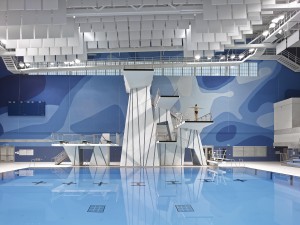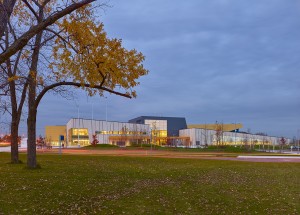
Five new PanAm Games venues achieve LEED
July 8, 2015
By
CCE

The PanAm Aquatics Centre at the University of Toronto – Scarborough. Photograph courtesy of NORR Limited, Architects Engineers Planners/Shai Gil Photography.
On the eve of the Toronto 2015 Pan Am/Parapan Am Games, the Canada Green Building Council (CaGBC) announced that five of the new facilities have earned LEED green building certification. The games start on July 15 and the five facilities have all been certified in the last few weeks. They are:
CIBC Pan Am/Parapan Am Aquatics Centre and Field House – certified LEED Gold on April 7;
CIBC Pan Am/Parapan Am Athletics Stadium — certified LEED Silver on May 27;
Cisco Milton Pan Am/Parapan Am Velodrome – certified LEED Silver on May 28;
CIBC Hamilton Pan Am Soccer Stadium – certified LEED Silver on May 28;
Atos Markham Pan Am/Parapan Am Centre – certified LEED Gold on June 12.
“The TORONTO 2015 Pan Am/Parapan Am Games Organizing Committee is pleased the Canada Green Building Council has recognized these five new builds with LEED certification,” said Saäd Rafi, chief executive officer, TO2015. “These facilities — as well as the many others built and upgraded for the Games with our funding partners — will improve Canada’s performance in international athletics, serve their communities and act as a sustainable legacy for future generations.”
Two additional facilities – the CIBC Pan Am/Parapan Am Athletes’ Village and the Welland Pan Am Flatwater Centre – are also registered for LEED certification.
The certifications are also noteworthy given that large athletic facilities can pose a unique challenge in green building due to their often large footprints.
For example, the CIBC Pan Am/Parapan Am Aquatics Centre and Field House at the University of Toronto-Scarborough uses geothermal energy from a field located underneath a parking lot. The project was designed by NORR as architects, Halsall-WSP as structural engineers, and Smith and Andersen as mechanical-electrical engineers.
Jim Derenzis, director of facilities management for the University of Toronto Scarborough, said: “Because swimming pools of this nature generally have significant utility consumption rates, we were particularly interested in targeting optimized energy performance. We achieved this by harnessing geothermal energy from the field located under the north parking lot of the facility; using building envelope materials that combat high humidity and contribute to overall building envelope and energy performance; and using unique air handling units that prevent condensation and reduce the energy demand required to heat the pools.”
Thomas Mueller, president and chief executive officer of CaGBC, said: “With the global exposure of the Pan Am Games, it was critical to ensure that buildings of this type and scale are built to leading sustainability standards. Aside from using sustainability to encourage greater indoor air quality and performance, Pan Am projects were guided by LEED to reduce utility costs and maintenance burden by maximizing energy and water efficiency. This included implementing tactics like advanced building automation, which allows owners to actively monitor building performance and respond dynamically to changing operational needs.”
To read the CaGBC press release, click here.

PanAm Aquatics Centre at University of Toronto – Scarborough. Photo courtesy of NORR Limited, Architects Engineers Planners/Shai Gil Photography.